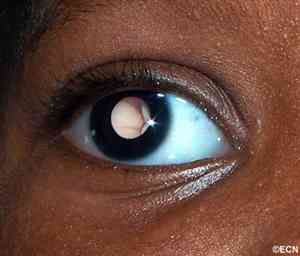
THE month of October is Cancer Awareness Month, and it is important to raise awareness about retinoblastoma, a rare type of eye cancer that is common in children, often under the age of five years.
It affects the retina, which is at the back of the eye. The retina sends signals to the brain to help you see. The World Health Organisation (WHO) recognises retinoblastoma as a significant cause of childhood cancer affecting one in every 15 000 live births leading to 8 000 new cases of retinoblastoma diagnosed globally each year.
The National Eye Health Strategy for Zimbabwe (2021 – 2025) highlights retinoblastoma as one of the eye conditions that causes childhood blindness. Many parents including health care professionals might not be aware of the symptoms and retinoblastoma goes undiagnosed until it is too late.
Symptoms include a white reflection in the pupil known as cat’s eye. It can be noticeable in photos taken with a flash or dim lighting.
One or both eyes may appear to be misaligned, which can sometimes be mistaken for lazy eye (amblyopia). In some cases, there can be persistent redness or swelling of the eye without any apparent cause which might not improve with usual treatments.
Young children may have trouble seeing, squinting or following objects with their eyes. The affected pupil may not respond normally to light and the affected eye might look different in size and appearance compared to the other eye.
Advanced retinoblastoma may cause pain due to increased pressure in the eye. If the cancer affects one eye in its early stages, the symptoms may be too subtle to detect during routine checks and the other eye may compensate for vision loss.
Young children may find it difficult to express or communicate vision problems, the discomfort or pain, making it difficult for parents to identify that something is wrong with their children’s eyesight.
In some cases, retinoblastoma may be inherited but some parents may not be aware of the family history on the condition, and they may not be alert to the need for early specialised screening. Parents of children with retinoblastoma experience a range of intense emotions. The initial diagnosis of retinoblastoma is devastating, and parents are overwhelmed with the fear of the cancer, which can lead to vision loss or death of the child.
Watching the child go through treatment options, such as surgeries and chemotherapy, leads to feelings of helplessness and anxiety. The treatment options require travel to specialised centres and the medical bills can impose a significant financial strain on parents.
More often, the emotional and financial stress can strain relationships between parents and other family members.
Early treatment will preserve the vision in one or both eyes. Delayed treatment can lead to vision loss or removal of the eye.
Retinoblastoma can be life-threatening if left untreated, it progresses to advanced stages. The cancer starts in the retina and can grow aggressively spreading to other parts of the body, such as the brain, bones and bone marrow, making it difficult to treat and significantly increasing the risk of death.
Recommendations
Retinoblastoma is highly treatable when caught early, hence increased awareness helps the parents, caregivers and healthcare professionals to recognise the symptoms.
Regular eye examinations, especially for children with a family history of retinoblastoma, are crucial. Multidisciplinary care involving specialists such as ophthalmologists, oncologists and radiation therapists is essential in providing personalised treatment and care depending on the severity.
Cancer diagnosis and treatment can be emotionally difficult for children and their families.
Connecting with other parents who have children with retinoblastoma helps reduce the feelings of isolation. Regular follow-up is essential for monitoring recurrence, managing any side effects and ensuring that the survivors receive rehabilitation services including visual aids or prosthetic eyes to adjust changes in vision or appearance.
In addition, children with hereditary forms of retinoblastoma have an increased risk of developing other cancers which may include brain tumours, further emphasising the importance of regular follow-up.
Careful management and care are necessary because while treatment like chemotherapy and radiation can be lifesaving, the treatments carry risks of side effects such as growth delays or secondary cancers.
Treatments like surgery or radiation may leave scars or cause facial changes hence prosthetic eyes should be made available for cosmetic reasons as the changes may affect the confidence and social interaction in children. Children with retinoblastoma vision loss may experience developmental delays particularly in tasks that rely on motor skills or reading. Retinoblastoma should be incorporated into the broader Cancer Awareness Month campaigns to ensure that the rare condition gets attention, helping to save lives.
It is important to increase access to eyecare services for children to enable early diagnosis, therefore, strengthening the primary health system through training specialists and improving the infrastructure to provide the critical cancer care will improve the survival rates and quality of life for children particularly in underserved communities.
Training of health professionals to recognise early signs can lead to timely diagnosis, which will significantly improve the outcomes. Financial assistance programmes for treatments such as chemotherapy, surgery or prosthetics will ensure that families are not financially devastated.
Such assistance programmes can include subsidies or low-cost treatment that can ensure access to services and on-going care. Resources should be allocated for funding research aligned towards therapies or potential cures. While the effects of retinoblastoma vary widely, early detection and timely treatment are crucial to save both the child’s vision and life.
- Tigere is a development practitioner and writes in her personal capacity. These weekly New Horizon articles, published in the Zimbabwe Independent, are coordinated by Lovemore Kadenge, an independent consultant, managing consultant of Zawale Consultants (Pvt) Ltd, past president of the Zimbabwe Economics Society and past president of the Chartered Governance & Accountancy Institute in Zimbabwe (CGI Zimbabwe). — kadenge.zes@gmail.com or mobile: +263 772 382 852.






